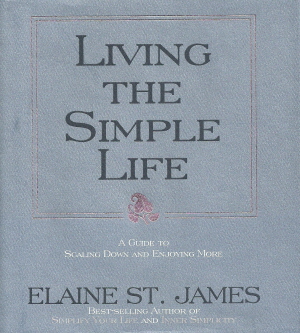 The following was posted in 2002. Review of Living the Simple Life: A Guide to Scaling Down and Enjoying More, by Elaine St. James. Hyperion, 1996, 350 pp. After roughly twelve frenetic years as a real estate investor, Elaine St. James looked at her to-do lists one day and decided that she had to simplify her life. She and her husband, a writer and editor, "had many of the trappings of the modern lifestyle, but we didn't have the time, and sometimes not even the energy, to enjoy them. And even worse, we had little time for each other, and practically no time for ourselves." Sound familiar? If your lifestyle makes you stressed-out, frazzled, discombobulated and unhappy, this book could be your lifeline. Some self-improvement and how-to books have a way of adding to our problems; their breathless style and endless to-do lists make us even more frazzled. But this is not that kind of book. St. James has a quiet approach. She makes many practical suggestions; but she does not bark out orders or make you feel that she'll show up on your doorstep tomorrow to see if you are doing the right thing. Her book is physically quiet, too, with a beautiful, spacious typeface, and simple, peaceful illustrations. The book suggests that simplifying your life may mean more than getting rid of clutter and scaling back on consumption. It may involve moving to a smaller home, quitting a job that makes you unhappy, and even changing to a new career. St. James herself has done all of these things. Instead of being an unhappy real estate investor, she now works fewer hours in a career of "writing that thrills me to the core." She is the author of several books on a topic she knows deeply: simplifying one's life. St. James suggests modest initial steps: First, decide you want to simplify; then set aside some time to think about it. She recommends spending a few days or a weekend in a retreat house, cabin in the woods or other getaway in order to examine your life and figure out how to make it less complicated. If that is not possible, she suggests, you can take an hour or more each day for awhile and use "a quiet table at your local library, or an empty pew in a church" to start thinking. How to find the time to do this? She suggests 25 different ways to find it. They include taking vacation days from work, minimizing household chores, unplugging your TV set, and avoiding all shopping except for groceries. Many of the suggestions have a double advantage: they enable you to try out possibly-permanent ways to simplify your life. The St. James approach is radical, but in most cases not ruthless. If you find it impossible to even think about a job change right now, she advises, don't focus on your job initially. Just try to simplify other parts of your life. Then, "as you pare away all the extraneous stuff, a new way of approaching your present job or an entirely different career opportunity may be staring you in the face." She does sound a bit ruthless, though, on the question of personal relationships. In speaking of friends and associates who do not understand why you want to simplify, she suggests that "you'll find it easy to move on from" such people. She outlines good ways of coping if your spouse does not want to simplify, but sounds cold when she says that in some cases "it may be necessary to consider a permanent change...I've heard from many people who've said that one of the most important steps they took was to move on from a spouse whose life was incompatible with their own desire to live simply." Far wiser, I think, was the approach of a neatnik I know whose husband is a clutterbug. Referring to an ugly piece of furniture that he insisted on keeping, she said she had decided that it was not worth a divorce. The neatnik and clutterbug are still happily married--partly because, I suspect, each has a sense of humor. St. James's husband was happy to join her simplification project; indeed, he wrote the chapter on simplifying men's clothing. But there apparently were other strains in their marriage, because a more recent St. James book includes thanks to her "former husband" for "his continued guidance, love and support." A poignant reminder that simplifying our lives does not solve all problems. St. James offers lots of how-to-simplify methods, some that she invented herself and some that her readers have suggested. In getting rid of clutter, she advises, "start with the easy stuff" such as your linen closet or kitchen; then use the momentum you've built up to tackle something hard such as piles of paper. And remember that throwing out lots of stuff will give you more space and also save you much time: "If you just get rid of the clutter," St. James notes, "you never have to organize it." She does not deal directly with the guilt many people feel about throwing out anything that might be useful to someone, somewhere. (This tendency begins as thrift and kindness, but can develop into neurotic hoarding.) But she does note that you can pass much stuff on to someone you know, give it to a charity, or put it out for recycling. After you have thrown out what you should throw out, you may want to follow some of her many ideas on how to keep the clutter from building up again. For example:
 St. James has excellent suggestions for people who find it hard to change their habits. After she and her husband decluttered and moved to a smaller home, they found, alas, "that we were going out and buying stuff to fill it up again." So they started a 30-day list. When they found something major that they wanted to buy, they held back and just wrote the item on a list. At the end of 30 days, they considered it again. Usually, though, "we couldn't remember why we wanted this thing in the first place." They also experimented with a three-month moratorium on all purchases except necessities. They found this so helpful that they extended it for three more months. "This was not about living in austerity or depriving ourselves of the things we need," St. James explains. "We approached it as a challenge and an opportunity to break the buying habits that had been a force in our lives. Not only did we save time and money and reduce the clutter that comes into our home, but we drastically changed our consumer mentality. We simply don't acquire stuff like we used to." Some of St. James's ideas, and ones she passes on from her readers, may appeal to some people but dismay others. Having designated house chores for each day of the week? This may work for some, but others would find it too regimented. Keeping track of one's weight on a chart posted above the bathroom scale? Doesn't this just make life more complicated and also encourage an obsession about weight? Many people would do better to get rid of the bathroom scale altogether. Switching from a wood-burning fireplace to a natural-gas one? Gas may be easier, cheaper and better for the environment, as St. James says; but promoting gas fireplaces encourages people to substitute the fake for the authentic--a process already too widespread in today's culture. Perhaps it would be better to keep the real thing, but use it less often. There are also a few chapters that have good points to make, but could express them better. St. James has useful things to say, for example, about turning down social invitations you simply do not want to accept. Do not feel guilty about this, she says; "it won't be the end of the world" for the hosts. "After all, when someone turns you down, you don't rush to the nearest cliff to leap off. No. You move on." On the other hand, she could suggest more gracious responses than she does in the chapter on "How to Say No." She gives excellent advice, though, about saying no to unreasonable time demands on a job. Noting that this may be more difficult than turning down social invitations, since your livelihood may be at stake, she suggests reducing your work time by roughly one-half hour for the next two months. "No one's going to miss you for that half hour," she says. "Besides, you may be amazed to find, as I did, that you're more productive when you're working less....You can then cut back even more." St. James offers helpful tips about simplifying life for children. She cites a reader whose family tackled the common problem of kids' over-involvement in extracurricular activities. The parents sat down with their two teenagers and, to the parents' surprise, everyone easily agreed to limiting each teen to one or two activities per season. The teens were relieved by the reduction of their obligations: "The kids are no longer exhausted from being constantly on the go. Their mother is relieved of the responsibility of being on call as the family chauffeur. Both kids' academic performance has improved dramatically and so has their performance in their chosen activity." She advises asking your parents and other relatives to limit their gifts to your children. And don't allow kids to throw tantrums in the grocery store because you won't buy the candy they want. She notes that the key to winning this battle is to "let your kids know what you will allow them to buy, if anything, before you go into the store, and then stick to that decision. Describe ahead of time what the consequences will be if they cry or throw a tantrum, and stick to that, too." She recommends strict limits on children's television time, partly because TV encourages children to be too passive and too dependent on others for their entertainment. She remarks that "any child who has developed the ability to think and do for himself or herself is going to have a decided advantage" in life. St. James suggests taking the time to teach your kids how to help with household chores and also "taking them on nature walks and bike rides, and teaching them to use the public library and spend quiet time there. Plant a garden, build castles in the sand or castles in the air, watch sunsets and sunrises." She acknowledges that this is more time-consuming at first than just "sitting them in front of the television. But in the long run, having happy children who love simple pleasures and who can be their own source for entertainment will make life simpler for you and for them." Life need not be, and should not be, as complicated and frazzling as it is for many of us today. This book can help us make it simpler and far happier.  |